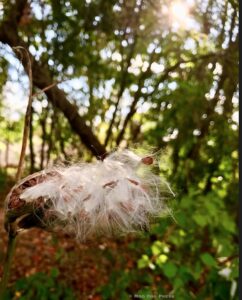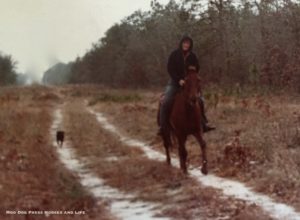COVID-19 Era: Of Autumn, Migrations, Trails • One Life Story, Tweeted
“Science knows no country because knowledge belongs to humanity, and is the torch which illuminates the world.”
So to conclude, we should not be thinking about Covid risks from an individual perspective, but rather from a community perspective. Our actions directly and indirectly affect those around us.
If I was able to change just one person's view with this thread, then it was worth it.
— Youyang Gu (@youyanggu) October 1, 2020
Note: For resources that help during the pandemic and into flu season, here is the link to that page. Masks on. Flu shot, check. Listen to science and follow best medical practices. Wash your hands, use hand sanitizer. Stay alert; find and listen to smart people. We're staying remote as a company, choosing to support local businesses. Subscribe to a newspaper or three. Feed your mind and think for yourself, do not follow the crowd.
Now to a timeless migration happening now, above a continent on the one planet we all share. You try it.
Float on biologically evolved wings with bright color and contrast southward across a continent. Avoid birds, vehicles and other hazards along the way. The destination is in encoded in your DNA; get there, stay alive, join others of your species. All seems impossible, yet Monarch butterflies are in the air on their way to Mexico right now.
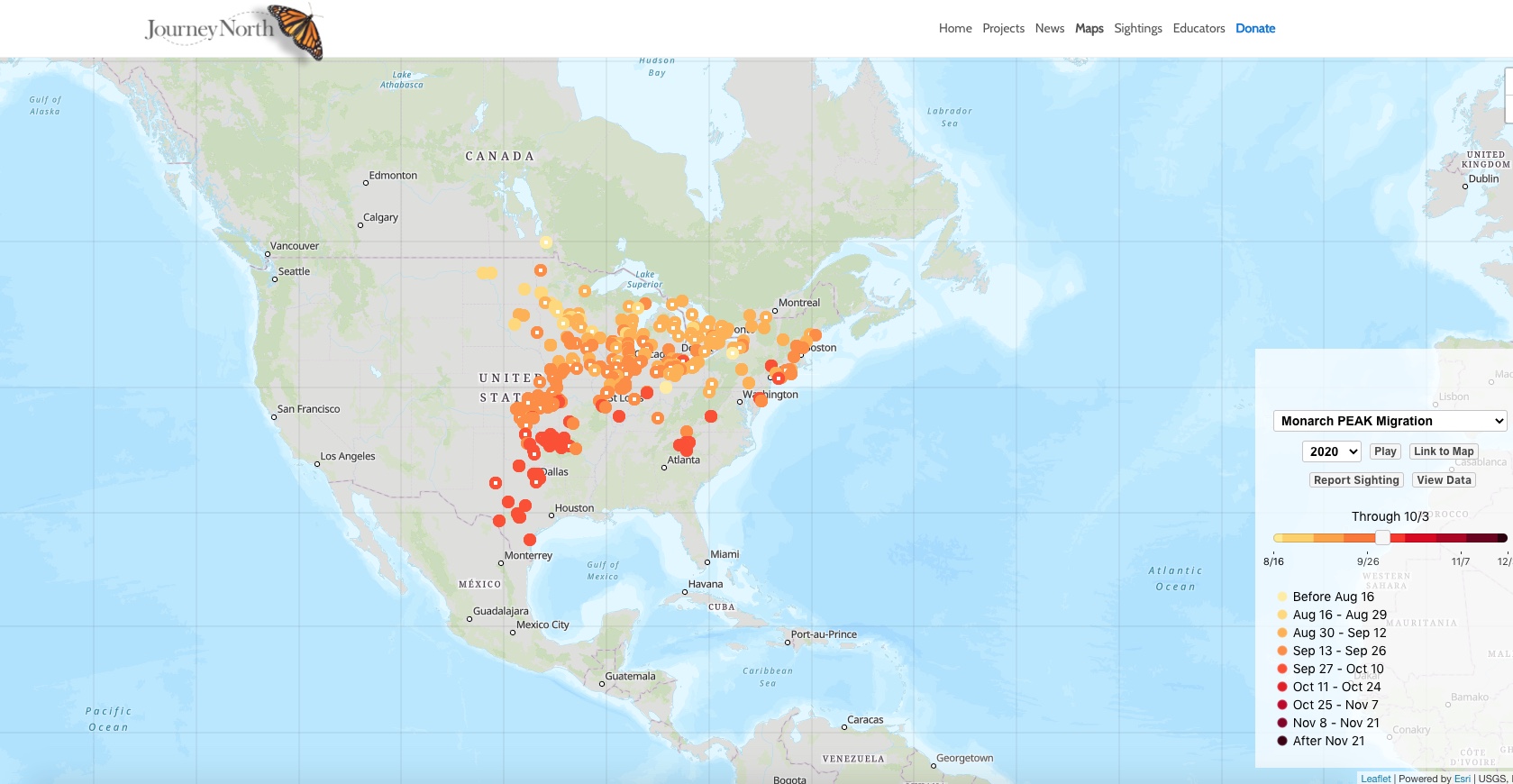
Track species like the Monarch across the continent with Journey North. Many other species move across time and space with the season, and you can participate as a citizen scientist. Image linked to official Journey North site.
Track Monarch butterfly migration with Journey North and view the travelers, gain appreciation for the journey.
“Report your sightings each fall and spring as the monarchs travel to and from Mexico. Track migration on real-time migration maps and follow the migration news. Fall migration extends from August to November; spring migration from March to June. Find out what to report each spring and fall. Scientists rely on the help of citizen scientists to understand the monarch’s conservation needs. Your observations make a valuable contribution — and help tell the dramatic story of the monarch’s journey to Mexico.”
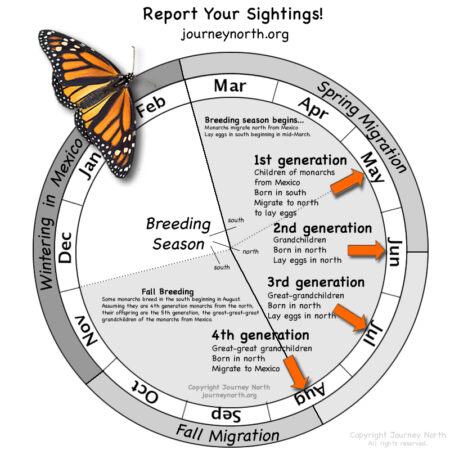
Visual science to understand generations and migrations. Image Journey North, linked to site for more information, resources for educators too.
For @MizWithers: Staring down the last three months of 2020. If ever there’s a time to go out swinging, fighting, singing, loving, trying, this is it. Hold on to your people, grab your snacks, let’s build a better world. Chin up.
— Jessica David (@JDinRI) September 30, 2020
A writer thinks like an entrepreneur: Hunt ideas and connections often missed by others. Distill those into a story or series. Words on a digital page, stories in ink on paper. Compiled and with the judgment of an editor and team, a book.
The journey many times takes the writer to an unexpected destination, one that did not exist before sitting down at the desk and keyboard. (Or whichever technique chosen to get the words out.) Similar to taking a trail and finding out so much more along the way. Lesser-known paths, community eateries, supplies, sources. While researching Short Nature Walks in Connecticut (GPP 6th edition), learned so much about the state and region, including libraries, stores, ice cream and pizza stops, local history. People who helped. Getting lost and navigating across meadows to find a road and back tracking. All this pre-cellphone, so carried maps, a whistle, first aid supplies, note pad and pencil as well as a pen (which will quit just when needed). A quality compass. Advice even in the digial age: Always leave a note behind about your destination. A map and compass, basic supplies still good to carry. Love technology which makes a digital platform possible (and research), but in moderation. The planet is an interconnected marvel of biological wonders; humans are learning what we don't know along the way of scientific discoveries each day.
Let's look at data about trails in the area. Stories of migrations of Monarch butterflies and other species intersect with trails and greenways. Places that preserve and promote species, ecosystems have great value to human health and wellbeing. Outings encourage curiosity and may cultivate future scientists and community leaders. And yes, writers, park rangers, teachers, parents, businesses who are part of a community. All maybe because of a teacher who led a class on a walkway near the elementary school, brought kindergarteners out to look up at a sycamore tree. Scout leaders like the late great Maureen Bilger who taught be example and connected a troop to local parks, camping, botany, trails, manners, sharing knowledge.
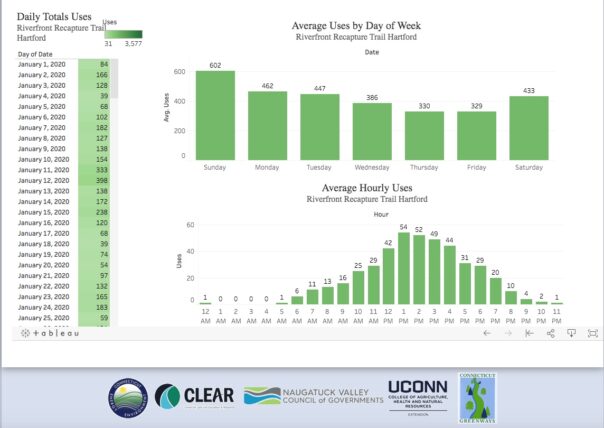
Data from UConn CLEAR, a site that has comprehensive information about trails, greenways, ways people use these resources which has enormous economic impact to communities and the region that is not always obvious to see while out enjoying nature and beauty. Here is Hartford, Riverfront Recapture, connected to the UConn CLEAR site.
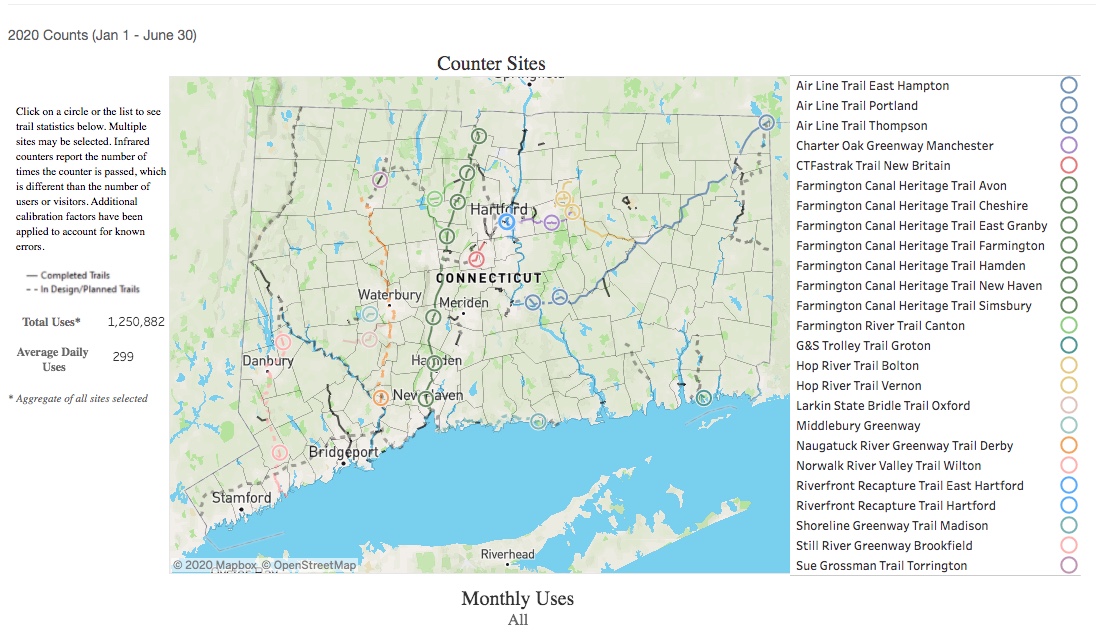
An interactive data map of trails; fascinating to view weather and usage patterns. Choose a location and view the data. CT Trail Census, linked to official site.
These one-page color, downloadable resources provide evidence-based information on the impacts of trails on physical and mental health, building community, stimulating economies, and fostering climate resilience. Each includes key data points from existing literature, a case study and a short list of recommendations. Communities highlighted include Meriden, Connecticut, New Haven, Connecticut, Canton, Connecticut, and Great Barrington, Massachusetts.
The health info-sheet includes six major benefits that trails have on promoting health. It recommends that communities animate trails with programs, increase public awareness about trails, and engage people not currently using trails. A case study on the Walk and Talk with a Doc initiative between Get Healthy CT and Yale Medicine in New Haven documents how trails have improved health outcomes for residents.
Trails drive economic development in communities through their positive impact on property values, expenditures at local businesses, and quality of life, among other attributes. The authors recommend that communities take a systems approach, connect their trails with downtown amenities, and engage and involve anchor institutions and local property owners in trail development. The Farmington Canal Trail in Canton provides further evidence of how the trail increased economic activity in the town.
“Our vision was a trail network that offered something for everyone in the community, from easy walks around Lake Mansfield to a rigorous hike along our piece of the Appalachian Trail,” says Christine Ward, Director of the Great Barrington Trails and Greenways in Massachusetts. Trails in any community are catalysts for increasing environmental awareness, creating connections, and strengthening community resilience. Steps to build community with trails include programming, analyzing trail use, and thinking community wide.
Climate change will bring many public health and safety threats to our communities and trails enhance resiliency through mitigation and by providing habitats for plants and wildlife. Trails also help decrease the carbon footprint of residents as more use the trails for travel. Communities enhance resiliency on their trails by making them feel safe and protected, encouraging residents to replace short vehicle trips, and connecting to transportation networks. A case study of Meriden shows how the trails and open space saved the downtown from flooding.
View all the impact sheets with the full benefits of trails and recommendations for community leaders at https://cttrailcensus.uconn.edu/trail-impact-series/.
One more. Devastating story in a series of tweets. Important.
My mother died of COVID-19 one month ago.
I am going to share the story of her illness in the hope that it helps someone. She was a doctor and always wanted to help people. If this informs anyone else’s behavior or care, maybe she still can. Please RT. 1/n
— Prof. Marianna Linz (@clim_dynamicist) September 30, 2020
May sharing this be a legacy, to help others.
Note: This story updated Oct. 2, 2020 when the importance of wearing a mask became illustrated by the news of top public servants testing positive for a virus despite denying it and encouraging others to ignore science.

